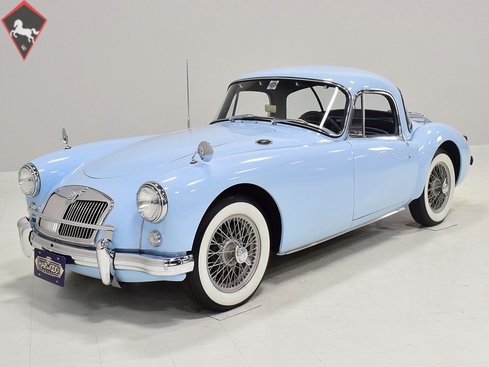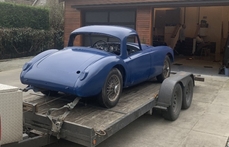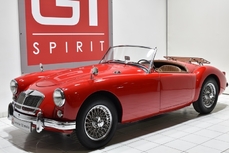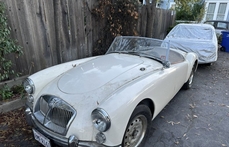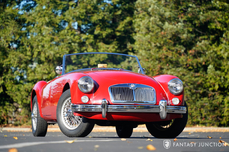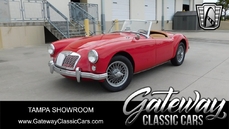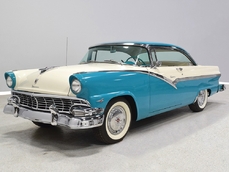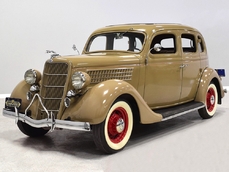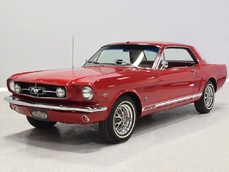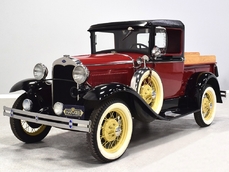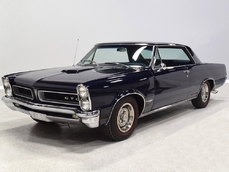MG MGA 1489 cc inline-4 1959
Allgemeine Beschreibung :
By the mid-1950s, it was increasingly clear that if MG wanted to stay in the sports car business, then a line of cars based on the aging pre-war TC chassis would have to be replaced. Facelifts that became the TD and TF models were able to slow the decline, but it didn’t take long to realize that a clean-sheet design was required. Engineered in almost record time, the MGA debuted in 1955 and was faster, lighter, and more comfortable than the TF it replaced. A coupe version was introduced in 1957, finally giving MG the grand touring car it needed to compete with some of the most recognized brands in Europe. It lost none of its energetic performance (the coupe’s weight penalty is less than 100 pounds) but gained all-weather comfort that no roadster could match.
This handsome light blue 1959 MGA 1500 coupe was featured in Volume 17, Number 1 of “Automobile Quarterly” and looks virtually the same today as it did 30 years go. Thanks to a high-quality restoration and conscientious maintenance over the years, it remains beautiful, comfortable, and a lot of fun to drive. The low-slung bodywork seems to look especially good with the coupe’s roofline, much the way Jaguar XK coupes stand out in a sea of open two-seaters. The original bodywork, including the aluminum hood (bonnet), doors, and trunk lid (boot), is in excellent condition with few signs of age and it’s worth noting that the roof itself was hand-formed over a buck to save money during production. The light blue paint is actually borrowed from a 1956 Buick color chart, a hue that’s somewhere between Glacier Blue and Iris Blue, and it looks wholly appropriate on the lightweight A. There’s a soft shine that’s the product of good workmanship and years of polishing, and most folks, if you ask them, will tell you the MGA is a much more expensive car than it is.
In addition, the chrome trim is in first-rate condition, including the front bumper that sports an accessory grille guard and bumper overriders. The mirrors perched way out there on the front fenders (wings) are actually quite useful and automotive journalists at the time of the MGA’s introduction loved the grille, about which The Autocar reported, “The designers are to be congratulated on providing an extremely attractive grille, retaining the classical MG appearance yet blending so well into the streamline form.” Delicate (and functional) grilles on the tops of the fenders exhaust engine heat and there’s a useful trunk rack on the rear deck, which was a popular period accessory. The taillights, of course, will look familiar to any British car fan and they’ve been filled with modern LED bulbs for better visibility. There’s simply nothing on it that isn’t beautiful to look at.
The interior has been more recently trimmed in blue vinyl with white piping, a fine contrast to the light blue bodywork. It still retains all the traditional styling cues, including vertical pleats, simple door panels, and a modestly padded dashboard, so there’s no question you’re in a proper British sports car. Controls are arrayed across the dashboard in an almost haphazard fashion, but their operation becomes familiar after a short drive, and we’re pleased to note that everything works. The big 4-spoke steering wheel has a matching blue leather wrap, but a peek underneath shows a plastic wheel in good condition. The only notable deviations from stock are a modern ammeter and a JVC AM/FM/cassette stereo head unit that powers a pair of speakers on the rear deck. The original Jaeger instruments are just lovely to look at and we decided to leave all the memorial plaques in place showing some of this car’s long history. The wood knob on the 4-speed shifter feels directly connected to the gearbox underneath and you’ll find that thanks to the all-new design, things like the heater and defroster are reasonably effective rather than a cruel joke. The headliner is in excellent condition with no splits or discoloration and there’s a reasonably-sized trunk with a correct spare and jack assembly, as well as a modest carpeted mat.
The 1500 cc inline-4 was an energetic performer, and it remains very entertaining today. Thanks to a full rebuild in 2017 (which was about 900 miles ago), it runs superbly. The list of new parts is extensive, virtually everything inside the block is new, plus things like the fuel pump, distributor (now with a Pertronix electronic ignition inside), and water pump. The twin SU side-draft carburetors were rebuilt and the wiring is new. Thanks to careful tuning, it starts easily with just a little choke and runs superbly on the open road. The block itself was painted familiar MG Maroon, with a polished aluminum rocker cover that adds a little flash. There’s also a fresh radiator up front, a shroud for the fan to improve cooling, and the big heater unit up on the cowl is fully operational. You should have no qualms about getting in and having some fun in this MG.
Underneath, it’s quite tidy, showing no signs of distress in the years since the first restoration. The 4-speed manual transmission shifts cleanly, the clutch and pressure plate are new, and it uses a fresh stainless steel exhaust system to give it that wonderful British baritone exhaust note. Rack-and-pinion steering was a nice upgrade on the MGA, giving it sharp reflexes that still feels contemporary, as well as freshly rebuilt drum brakes at all four corners. The floor boards are still wood, so no worries about rust or rot there, and the frame is surprisingly robust for such a small car—it seems somewhat over-built, if you can believe it. There’s a fresh battery in the tray just ahead of the rear axle, and the gas tank was cleaned out and freshened so it’s happy with today’s fuels. It’s refreshing to see painted wire wheels, which carry a set of 5.60-15 Champion wide whites that look and feel period-perfect.
Extras include a large file of receipts, a maintenance log book that’s actually been updated properly, the “Automobile Quarterly” in which this car appears, a jack and knock-off hammer, plus a rather substantial cache of spare parts and service items.
If you’ve been watching carefully, you’ve seen prices on most of the popular British sports cars inching upwards, and the MGA is no exception. This beautiful coupe is exactly the right car for the enthusiast who likes to drive, with a rebuilt engine and beautiful cosmetics that aren’t so perfect that you’re afraid to get it dirty. For many of us, the real thrill of owning an old car is to put it on the road, and that’s especially true with this beautifully maintained MG. Call today!
http://www.harwoodmotors.com/vehicles/inventory_details.php?id=1009
1959 MG MGA 1489 cc inline-4 is listed verkauft on ClassicDigest in Macedonia by for $24900.
Fakten der Auto
Karosserietyp : Auto Marke : MG Modell : MGA Ausführung : 1489 cc inline-4 Hubraum : 0.0 Modelljahr : 1959 Karosstyp : Coupé Lage : Ohio
Verkauft
Angaben Zum Verkäufer
Verkauft
People who viewed this MG MGA also viewed similar MG listed at ClassicDigest
Other cars listed for sale by this dealer
über MG
Die Geschichte von MG (Morris Garages) ist ein reiches Geflecht, das mehrere Jahrzehnte umspannt und verschiedene Besitzer sowie Unternehmensstrukturen einbezieht. Hier ist eine Übersicht über die MG-Geschichte von ihrer Gründung bis zur schwierigen Phase unter der British Leyland (BL) Corporation, wobei wichtige Modelle und ihre Spezifikationen hervorgehoben werden:1. Gründung und frühe Jahre:
Gründungsjahr: 1924
Gründer: Cecil Kimber
Anfänglicher Fokus: Karosseriebau und Anpassung von Morris-Autos.
2. MG-Oktogon-Logo:
Das ikonische MG-Oktogon-Logo wurde eingeführt und repräsentiert die Fusion von MG mit Morris.
3. MG M-Type Midget (1929–1932):
Wichtige Merkmale:
Kompakter Zweisitzer.
Angetrieben von einem 0,8-Liter-Motor.
Der Beginn der Midget-Serie.
4. MG T-Series (1936–1955):
Wichtige Modelle:
MG TA, TB, TC, TD, TF
Wichtige Merkmale:
Roadster mit klassischem Design.
Erfolg im Motorsport, insbesondere in der Zeit vor und nach dem Zweiten Weltkrieg.
5. Nachkriegszeit und MG A (1955–1962):
Wichtige Merkmale:
Abkehr vom traditionellen Design.
Erster MG mit einem stromlinienförmigen, modernen Design.
Erhältlich als Roadster oder Coupé.
Angetrieben von einem 1,5-Liter-Motor.
6. MG B (1962–1980):
Wichtige Merkmale:
Klassisches Design britischer Sportwagen.
Erhältlich als Roadster oder GT-Coupé.
In großen Stückzahlen produziert.
Varianten inklusive des leistungsstarken MGC.
7. MG Midget (1961–1979):
Wichtige Merkmale:
Kompakter Sportwagen auf Basis des Austin-Healey Sprite.
Erschwinglich und beliebt.
Verschiedene Iterationen mit Motor-Upgrades.
8. MG C (1967–1969):
Wichtige Merkmale:
Eine leistungsstärkere Version des MGB mit einem 2,9-Liter-Reihensechszylinder.
Begrenzte Produktion.
9. Ära der BL Corporation (1968–1980):
Übernahme durch British Leyland (BL):
MG wurde Teil des größeren Konzerns British Leyland.
Schwierigkeiten bei der Qualitätskontrolle und Arbeitskonflikte.
Rückgang der Produktqualität und des Rufes.
10. MG MGB GT V8 (1973–1976):
Wichtige Merkmale:
Einführung eines werkseitig produzierten MGB mit einem V8-Motor.
Versuch, während schwieriger Zeiten Leistung in die Modellpalette einzuführen.
11. MG RV8 (1992–1995):
Wichtige Merkmale:
Begrenzte Produktion des Cabrios.
Wiederbelebungsversuch durch die Rover Group (Nachfolger von BL), um den klassischen MG-Geist wiederzubeleben.
Die MG-Geschichte während der Ära von British Leyland markierte eine schwierige Phase mit einem Rückgang von Qualität und Ruf. Dennoch bleibt die Marke weiterhin mit klassischen britischen Sportwagen verbunden.
